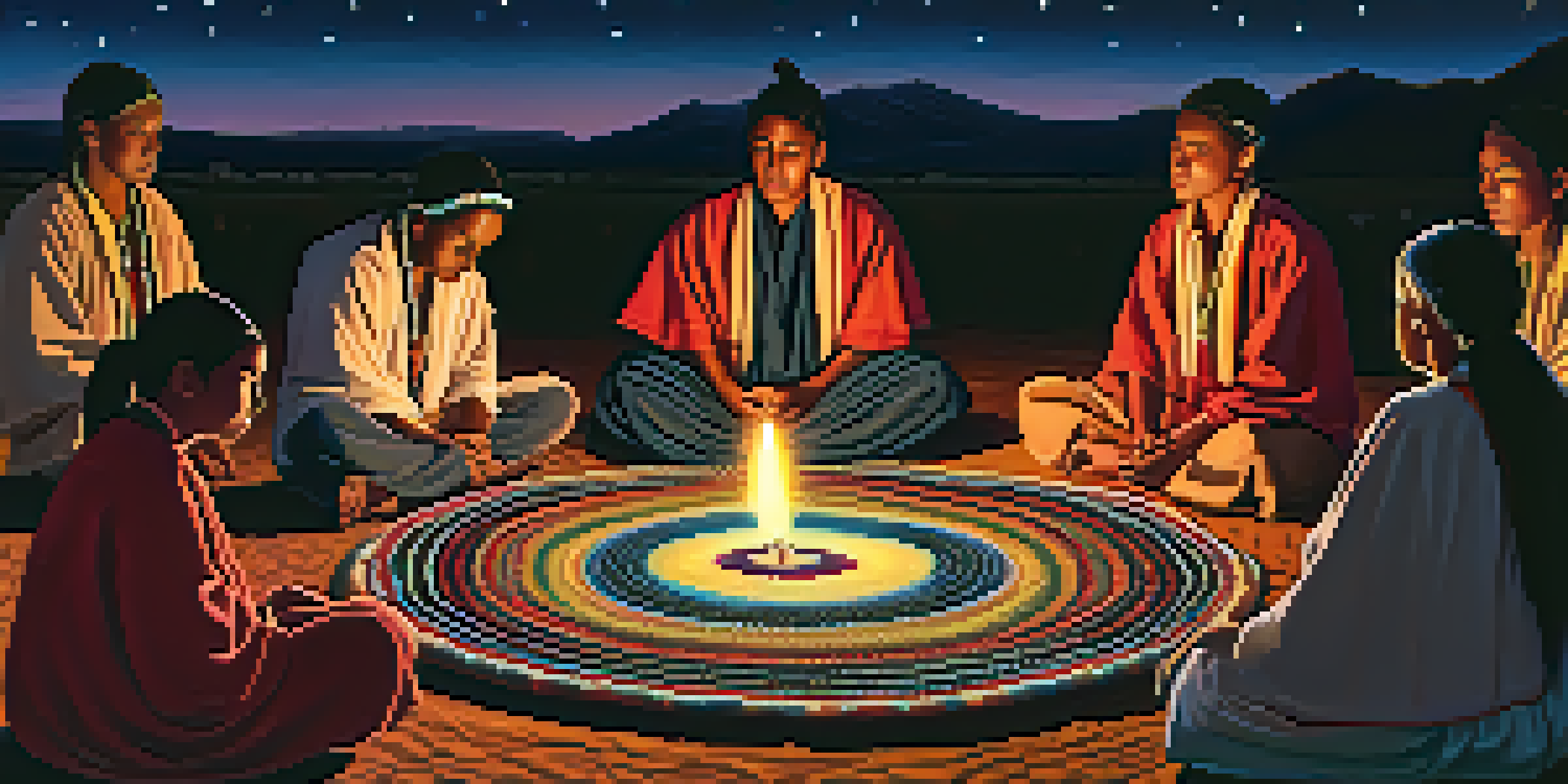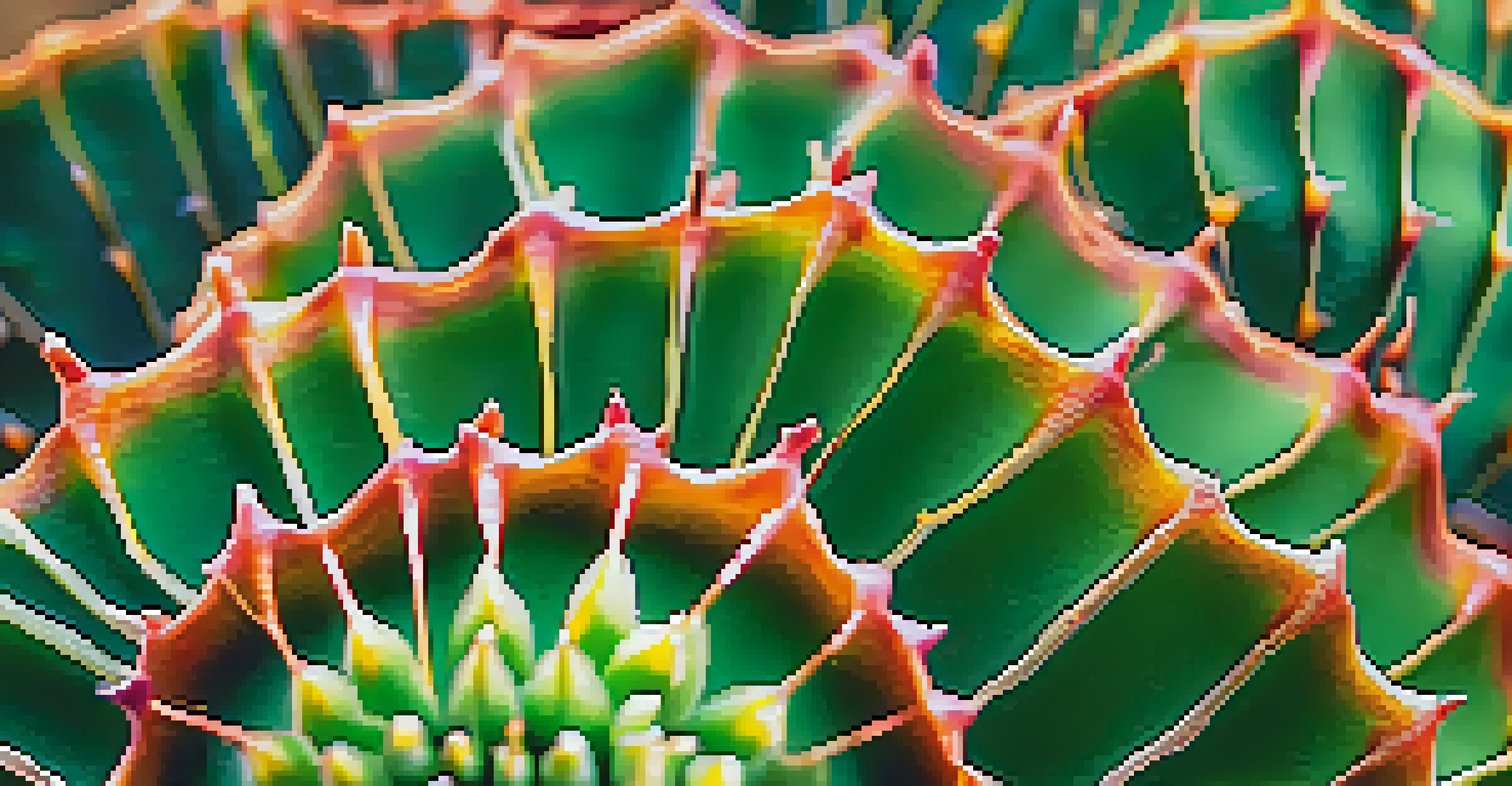The Significance of Peyote Ceremonies in Native American Culture

What is Peyote and Its Cultural Importance?
Peyote is a small cactus native to Mexico and the southern United States, known for its psychoactive properties. For many Native American tribes, it represents much more than just a plant; it's a sacred entity deeply woven into their cultural fabric. The cactus is revered for its ability to facilitate spiritual experiences, making it a vital part of religious practices.
Peyote is a sacred medicine that brings healing and insight, connecting us to our ancestors and the spirit world.
In many tribes, including the Huichol and the Navajo, Peyote is viewed as a gift from the Creator, with the power to heal and connect individuals to the divine. Its consumption during ceremonies is believed to foster introspection and community bonding. This reverence highlights a profound relationship between the people and the natural world, emphasizing respect and gratitude.
Moreover, Peyote ceremonies serve as a spiritual bridge, linking generations and preserving ancient traditions. The continued practice of these ceremonies underscores their significance, not just as a ritual but as a means of cultural survival and resilience.
The Structure of a Peyote Ceremony
A traditional Peyote ceremony often takes place over several nights, guided by a leader known as a roadman. This structure creates a sacred space where participants can engage in prayer, singing, and sharing their visions. The roadman plays a crucial role, facilitating the experience and ensuring that the rituals are conducted respectfully and in accordance with tradition.

During the ceremony, participants typically consume Peyote in a communal setting, fostering a sense of unity. This collective journey into the spiritual realm emphasizes the importance of community, as individuals support one another through their experiences. The atmosphere is often filled with drumming, singing, and storytelling, all of which enhance the spiritual environment.
Peyote's Cultural Significance
Peyote is a sacred cactus for many Native American tribes, serving as a vital element in their spiritual practices and cultural identity.
The ceremony's structure is not merely about consuming Peyote; it's about creating a safe space for personal and communal healing. Participants often emerge with newfound insights and a deeper connection to their culture, reinforcing the significance of these rituals in their lives.
Healing and Peyote: A Spiritual Connection
For many Native Americans, Peyote is considered a powerful medicine, capable of addressing both physical and spiritual ailments. The experiences during the ceremony can lead to profound emotional release and healing, making it a therapeutic practice for those involved. This aspect of Peyote use highlights its importance as a tool for personal transformation.
In the dance of life, Peyote serves as a bridge between the physical and spiritual realms, guiding us on our personal journeys.
Participants often report clarity of thought and emotional catharsis during Peyote ceremonies. This transformative experience is believed to come from the deep introspection facilitated by the Peyote's psychoactive effects. Through this journey, individuals can confront personal issues and find resolutions, strengthening their mental well-being.
Moreover, the healing aspects extend beyond the individual. When one person heals, it can positively impact the entire community, fostering harmony and collective well-being. This interconnectedness is a vital principle in Native American culture, where the health of the individual is seen as intrinsically linked to the health of the community.
The Role of Music and Rituals in Ceremonies
Music plays a fundamental role in Peyote ceremonies, serving as a medium for spiritual expression and connection. Traditional songs, often passed down through generations, are sung to invoke spirits and create a sacred atmosphere. The rhythmic drumming and chanting help participants enter a meditative state, enhancing their spiritual experience with Peyote.
Rituals accompanying the Peyote ceremony are rich in symbolism and meaning, reinforcing the beliefs and values of the community. Each action, from the lighting of candles to the sharing of stories, is laden with significance, helping participants to focus their intentions and energies. These rituals create a sense of continuity, linking the present to the past.
Healing Through Peyote Ceremonies
The consumption of Peyote during ceremonies fosters emotional healing and personal transformation, benefiting both individuals and their communities.
Through music and ritual, participants not only engage with the Peyote but also with their cultural identity. This connection strengthens the bonds within the community and fosters a sense of belonging, emphasizing that these ceremonies are as much about cultural preservation as they are about spiritual exploration.
Peyote and the Concept of Vision Quests
Vision quests are an integral part of many Native American spiritual practices, often intertwined with Peyote ceremonies. These quests involve seeking personal visions and insights, typically undertaken in solitude or during a ceremonial setting. Peyote can enhance this experience, providing clarity and deeper connection to one's inner self.
During a vision quest, individuals may consume Peyote to open pathways to spiritual realms, allowing them to receive guidance from ancestors or spirits. This process is deeply personal and can lead to significant life changes, as participants often emerge with a stronger sense of purpose and direction. The insights gained can guide them in their daily lives and decision-making.
The combination of vision quests and Peyote underscores the importance of introspection in Native American culture. These practices encourage individuals to reflect on their lives, fostering personal growth and a deeper understanding of their place within the universe.
Legal and Ethical Considerations Surrounding Peyote Use
The use of Peyote is surrounded by legal and ethical discussions, particularly concerning its status in the United States. While it is classified as a controlled substance, there are exemptions for its use in religious ceremonies by recognized Native American tribes. This legal framework highlights the importance of respecting cultural practices while navigating modern regulations.
Ethically, the use of Peyote raises questions about cultural appropriation and the commercialization of sacred traditions. As interest in Peyote grows outside Native American communities, there is a risk of diluting its significance and meaning. It is crucial to approach these ceremonies with respect and understanding, honoring their deep cultural roots.
Challenges for Peyote's Future
The future of Peyote ceremonies faces challenges from cultural appropriation and the need for preservation amidst growing interest in indigenous practices.
Navigating these legal and ethical landscapes requires a commitment to cultural sensitivity and awareness. Supporting indigenous rights and acknowledging the sacredness of Peyote ceremonies is essential in ensuring that these practices are preserved and respected for future generations.
The Future of Peyote Ceremonies in Native American Culture
As society evolves, the future of Peyote ceremonies poses both challenges and opportunities for Native American communities. The growing interest in indigenous practices has sparked conversations about the importance of preserving these rituals while navigating modernity. Ensuring that these ceremonies remain authentic and meaningful is vital for cultural continuity.
Community leaders are actively working to educate others about the significance of Peyote and the traditions surrounding its use. This outreach effort aims to foster respect and understanding, ensuring that the ceremonies are appreciated for their cultural heritage rather than being commodified. The future relies on a balance between tradition and contemporary relevance.

Ultimately, the resilience of Native American cultures will determine the future of Peyote ceremonies. By passing down knowledge and practices to younger generations, these communities can ensure that their rich traditions continue to thrive, maintaining the spiritual and cultural significance of Peyote for years to come.